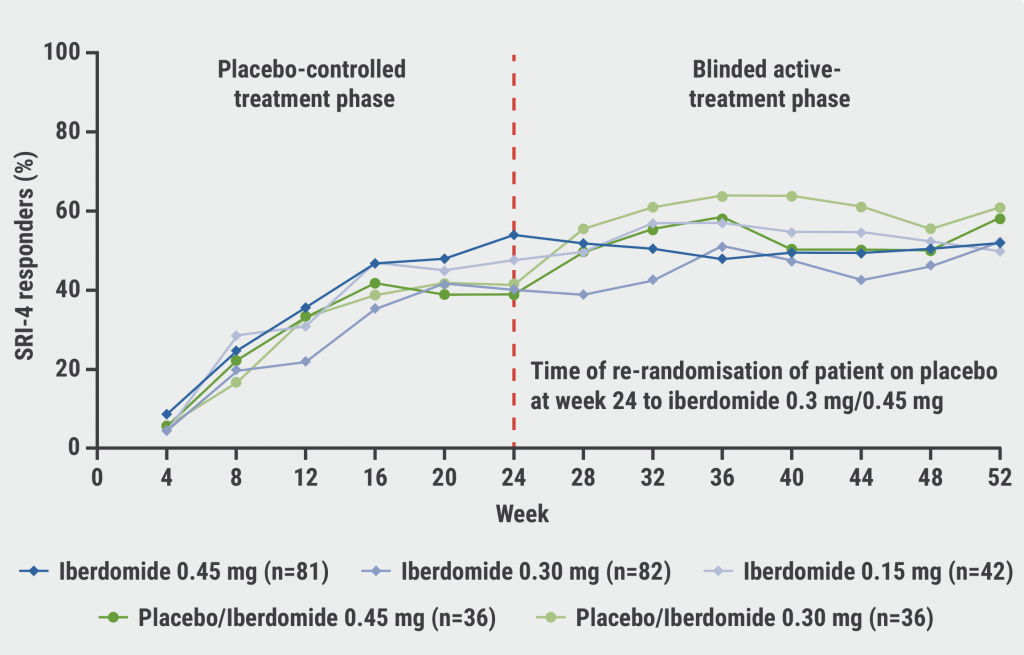https://doi.org/10.55788/66ea1474
In the FUTURE 2-5 trials, subcutaneous secukinumab resulted in rapid and sustained improvement of symptoms in participants with moderate-to-severe PsA [1-4]. No study has yet evaluated the safety and efficacy of IV secukinumab. The randomised, double-blind, placebo-controlled, phase 3 study INVIGORATE-2 (NCT04209205) was conducted to address this gap [5]. All included participants with active PsA had symptoms for ≥6 months, a tender joint count of 78 joints (TJC78) ≥3, and a swollen joint count of 76 joints (SJC76) ≥3. In this study, 381 patients were randomised to receive IV secukinumab (n=191) or placebo (n=190) during the first 16 weeks. Afterwards, participants from the placebo group switched to IV secukinumab through week 52.
A significantly higher proportion of participants in the secukinumab group (31.4%) reached the primary efficacy endpoint, which was ACR50 response after 16 weeks, compared with the placebo group (6.3%; P<0.0001). The secondary binary efficacy outcomes were also met, including achieving an ACR20 response, minimal disease activity, Psoriasis Area and Severity Index-90 (PASI90), and resolution of dactylitis and enthesitis. Continuous outcome measures improved at 16 weeks as well, including the nail psoriasis severity index, which is notoriously difficult to achieve.
Among participants who were switched to the active treatment after 16 weeks, the ACR50 response rate increased as soon as week 20. Both groups had similar ACR50 responses after 1 year: 58% in the secukinumab group and 64% in the placebo/secukinumab group.
The safety profile was consistent with the known previous findings, without new signals. In the first 16 weeks, the incidences of adverse events (AEs) in the experimental and placebo groups were similar (37.7% vs 38.4%, respectively). The rate of serious AEs was 1.6% and 2.1%, while the AEs rate leading to treatment discontinuation was 0.5% and 1.6%, respectively. No new cases of inflammatory bowel disease or uveitis were reported.
- McInnes IB, et al. Arthritis Res Ther. 2018;20(1):113.
- Nash P, et al. Arthritis Res Ther. 2018;20(1):47.
- Orbai AM, et al. J Clin Rheumatol. 2018;24(S3):364.
- Mease P, et al. Ann Rheum Dis. 2018;77(6):890–7.
- Kivitz A, et al. Efficacy and safety of intravenous secukinumab for the treatment of active psoriatic arthritis: 16- and 52-week results from a randomized, double-blind, phase 3 study. 0776, ACR Convergence 2023, 10–15 November, San Diego, USA.
Medical writing support was provided by Michiel Tent.
Copyright ©2023 Medicom Medical Publishers
Posted on
Previous Article
« Apremilast in early oligoarticular PsA: phase 4 study results Next Article
CAR-T cell therapy results in sustained lupus remission »
« Apremilast in early oligoarticular PsA: phase 4 study results Next Article
CAR-T cell therapy results in sustained lupus remission »
Table of Contents: ACR 2023
Featured articles
Ixekizumab resolves nail psoriasis better than adalimumab in PsA
IV secukinumab safe and effective for long-term treatment of active PsA
Rheumatoid Arthritis
Short-term glucocorticoid use increases the risk of MACE
Positive efficacy and safety results of novel BlyS/APRIL inhibitor in RA
Baricitinib superior to TNFi in patients with RA who failed csDMARDs
Lupus
Encouraging results of afimetoran in participants with cutaneous lupus
CAR-T cell therapy results in sustained lupus remission
Osteoarthritis
Repeat steroid injection in knee osteoarthritis possibly beneficial
Osteoporosis
Romosozumab tops denosumab in glucocorticoid users with high fracture risk
Psoriatic Arthritis
Ixekizumab resolves nail psoriasis better than adalimumab in PsA
IV secukinumab safe and effective for long-term treatment of active PsA
Apremilast in early oligoarticular PsA: phase 4 study results
Gout
Novel selective URAT1 inhibitor shows promise in gout
Fibrosing rheumatic diseases
Incidence and risk factors for new-onset interstitial lung disease
No need to avoid TNF inhibitors in RA-ILD?
Vasculitis
Reduced-dose glucocorticoids in GPA and MPA increase mortality
Related Articles

January 18, 2021
Poor disease control: a risk factor for severe COVID-19

© 2024 Medicom Medical Publishers. All rights reserved. Terms and Conditions | Privacy Policy
HEAD OFFICE
Laarderhoogtweg 25
1101 EB Amsterdam
The Netherlands
T: +31 85 4012 560
E: publishers@medicom-publishers.com

